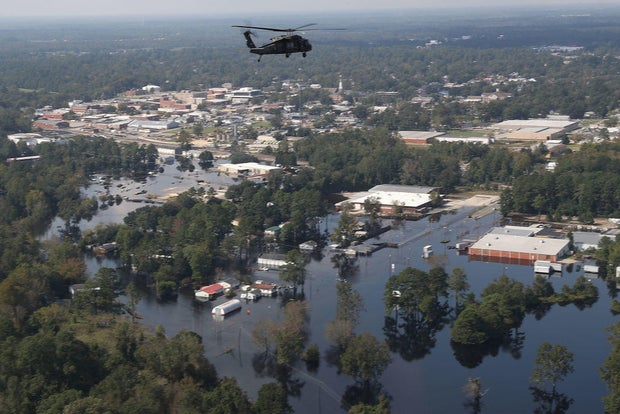North Carolina community devastated by flooding from 2 prior storms braces for Debby
As Tropical Storm Debby heads north, the heavy rain brings with it the potential for catastrophic flooding in parts of Georgia and North and South Carolina. And the threat of major inland flooding from these storms appears to be growing.
Hurricane Matthew sucker punched Lumberton, North Carolina, back in 2016. Nobody in that town, which is 80 miles inland, saw 20 inches of rain coming. The Lumber River crested 11 feet above flood stage and swamped the city.
Six-foot-three Fire Chief Jimmy Hunt recalled the water was up to his chest. Back in 2016, he rescued roughly 50 people, most of them elderly, from the floodwaters.
"It's pretty horrific, what we've seen out there," he told CBS News at the time. "Ten to 15 minutes from the time the water came over, it flooded their homes. ...It was just survival at that time."
Two years later, Hurricane Florence struck. Florence made landfall as a Category 1 hurricane and brought with it more than 35 inches of rain in parts of North and South Carolina over two days.
"It really boggles the mind that this same thing can happen again," said Brianna Goodwin, a community organizer in Lumberton with the Robeson County Church and Community Center.
"It was almost this feeling of being shell-shocked," she said, recalling the 24 inches of rain that inundated the area. "Like, I see the flooding. I see the water. But is this real?"
Hurricane flooding ruined Sheila Moore's house twice in Lumberton. "We literally lost everything," she said.
She had redone the house after it was destroyed by Hurricane Matthew, only for Florence to wipe it out again in 2018.
"That was devastating," Moore said.
Lumberton twice learned the hard way that today's hurricanes can target communities far from the coast.
Warmer oceans fuel storms and the warmer atmosphere holds more moisture. That increased moisture leads to increased precipitation. According to recent modeling from the National Oceanic and Atmospheric Administration, rainfall rates will increase between 10-15% on average within about 62 miles of most storms as the Earth approaches 2 degrees Celsius of warming.
"Not only are storms getting more intense, slower moving and water-laden, but the populations are changing," said Gavin Smith, a professor at North Carolina State who studies the impact of climate change on natural disasters. "And the people moving into these areas may not fully understand the impact."
In 2016, more than 800 Lumberton residents were in shelters because of the flooding. There could be a lot more Lumbertons going forward. In roughly 30 years, storms could cause flooding damage to more than 19 million properties, both coastal and inland, according to analysis from CBS News and First Street. But only about 25% of those would have flood insurance.
Years after Matthew and Florence, Lumberton has only partially recovered, physically and psychologically.
"There's something that can destroy your home, and that's just not a very easy feeling to have," Goodwin said.





